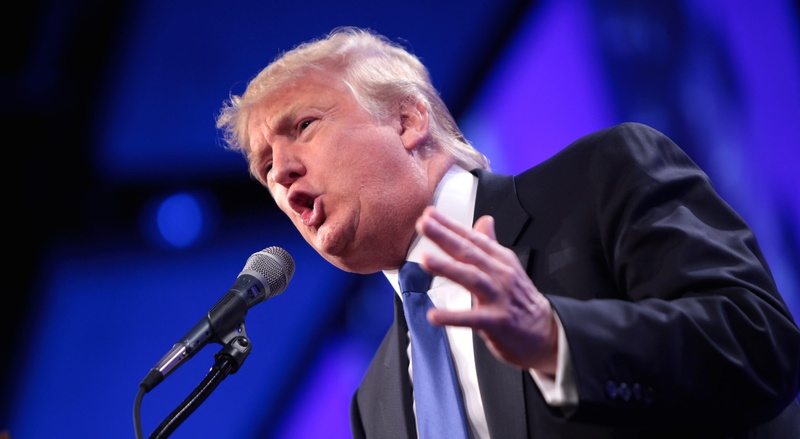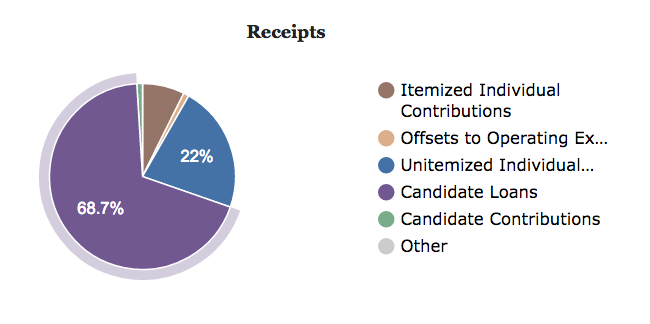Is Donald Trump really self-funding his presidential campaign?

When we previously dissected Donald Trump’s claim of self-funding his campaign last November, it wasn’t exactly true. But after examining the latest fundraising numbers, his assertion now holds a bit more weight.
After the Feb. 20 campaign finance deadline, Trump has now poured in over $17.7 million of his own money – that’s over 70 percent of the $25.5 million his campaign has raised over the entire cycle. Nearly all of that ($17.5 million) came in the form of loans; meanwhile, none of the other candidates have loaned their campaigns so much as a dime.1 On top of that, he’s also supplied over $250,000 worth of in-kind contributions, such as rent and payroll, to his committee.
But his claim of totally self-funding is still not entirely true: Other donors make up a significant chunk of his campaign cash — nearly 30 percent — totaling $7.5 million in contributions.
Business as usual?
During the last quarter of 2015, Trump’s campaign raised $13.5 million, less than GOP rival Ted Cruz ($20 million) and on par with Marco Rubio ($14 million). But, unlike those two, Trump’s haul came straight from the candidate — $10.8 million in loans. This trend continued into the new year, too: During January, his campaign raised just $941,000 from donors while Trump again emptied his own pockets — this time to the tune of nearly $5 million.
Before these latest fundraising numbers, it would have been reasonable to put a big asterisk next to Trump’s self-funding claims, as Sunlight Policy Analyst Richard Skinner mentioned in a Politifact article from earlier this month. Now, however, it is much more accurate — though still not entirely factual.
No PACs, no problem?
Trump enjoys minimal PAC support compared to his opponents; while Cruz has a plethora of super PACs backing him, Rubio employs dark money organizations and Hillary Clinton enjoys the support of both, Trump disavows having any relationship with any outside group. (It’s worth noting that Bernie Sanders largely distances himself from outside money as well, aside from a nurse’s union super PAC.)

But with the campaign ramping up, Trump’s spending is still low compared to other White House hopefuls, and he may need even more money to keep up.
Making a media mogul
When the media hands you abundant attention, you don’t need to buy advertisement spots. And when you don’t buy ad slots, your expenditures can be shockingly low. While Trump’s campaign spent just $6.87 million between October and December of 2015, it cashed in big during January, doling out $11.5 million. The campaign has spent, $23.7 million so far, considerably less when compared to Cruz ($41 million) and Rubio ($33 million).
And with Trump now running television ads to secure the GOP nomination, he may need more cash on hand to compete with either Hillary Clinton ($32.9 million) or Bernie Sanders ($14.6 million) in the general election — currently, Trump has just $1.5 million in the bank.
Following the money merchandise
If you count swag as a form of political donations, as the FEC does, then Trump leverages it to “Make America Great Again.” By pricing merchandise higher than the cost it takes to manufacture, candidates profit – just like private businesses. Aside from increasing candidate’s coffers, official merchandise helps solicit more donations by advertising the campaign’s message. While Trump is not alone in selling novelty items with Groupon discounts, few candidates sell items that pervaded pop culture like his iconic red hat. (We highlighted some of our favorite political Christmas gifts here.)
Riding Trump’s coattails
At least 30 House and Senate candidates have already personally seeded their campaigns with $250,000 or more, according to Politico, and that’s more than double the number of major self-funders at this time in 2012. Rep. David Jolly, a Republican who is vying to replace Rubio’s Senate seat in Florida, refuses to raise money for his campaign, reports Matt Laslo at The Daily Beast.
While other candidates are following suit, Trump didn’t pioneer the practice of funding a White House run with a personal bank account. Candidates like Ross Perot, Steve Forbes and others have given millions, only to come up short. “Mitt Romney spent $44.7 million on his failed primary run in the 2008,” writes Sunlight’s Melissa Yeager, analyzing our current “bring-your-own-billionaire” election. “Seemingly learning from that lesson, he only gave around $52,000 to his campaign in 2012.”
There’s a common theme for all those who have tried it before: None of them have ended up in 1600 Pennsylvania Avenue.
Trumping the field
Trump blurs the line between money that was lent to him and money donated outright. During the 2000 election when Trump flirted with an election bid, he hinted at the candidacy being as much of a capitalist endeavor as a legitimate candidacy.
“It’s very possible that I could be the first presidential candidate to run and make money on it,” Trump said at the time.
By loaning his campaign money and not donating it, Trump stands to potentially recoup his investment. The interest-free loans don’t have to be repaid until at least Dec. 31, 2016, and Trump could ultimately decide to write them off. Voters view Trump as working without special interests. Him contributing eight figures to his own campaign and operating without outside groups, like a super PAC, makes that claim appear more legitimate. We just hope the next time he drops the self-funding line, he doesn’t ignore the $7 million he’s received in outside donations.
—–
1 It’s worth noting that Clinton has made about $500,000 worth of in-kind contributions in the form of rent, office supplies and more to her campaign. (Back to top ↑)

